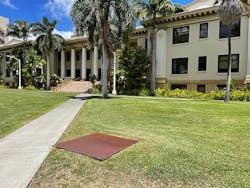Microgrids, Energy Efficiency and Renewables part of DOE Island Resiliency effort
Island communities from the U.S. East Coast to Upper Midwest, Alaska, western Pacific, northwest, Gulf of Mexico and Hawaii are gaining federal funding to reduce carbon emissions and improve resiliency in their energy systems.
The U.S. Department of Energy has selected 12 remote and island communities to help strengthen their energy infrastructure, reduce the risk of outages and improve energy and economic outlook.
The DOE will support the projects through the Energy Transitions Initiative Partnership Project (ETIPP), which supports the Biden-Administration's goal of an equitable transition to a future free of carbon-pollution.
“As climate change intensifies, remote and island communities, which experience higher energy costs and may lack the financial resources and expertise to make their energy systems more resilient, are more at risk to extreme weather events,” said U.S. Secretary of Energy Jennifer M. Granholm. “DOE will connect 12 more communities with our world-renowned National Labs to execute strategic and locally-tailored clean energy and resilience solutions, driving the nation’s equitable transition to a net-zero economy.”
The 12 communities are Aquinnah and Chilmark in Massachusetts, Bainbridge Island and Makah Tribe, Neah Bay in Washington, Beaver Island in Michigan, Guam Power Authority in Guam, Hui o Hau'ula in Hawaii, Igiugig and McGrath in Alaska, the Microgrid of the Mountain of Puerto Rico, the Mount Desert Island in Maine, Nikolski and St. George in Alaska and the University of Hawaii.
The ETIPP will leverage DOE’s experts and the National Labs to help these communities transition to clean energy and improve resilience.
In Aquinnah and Chilmark, retrofits will be recommended for municipal buildings, distributed energy resources and microgrids to help achieve 100% renewable energy by 2040. The towns will be able to identify suitable renewable and energy efficiency solutions to reduce GHG emissions and improve resilience.
ETIPP will analyze the feasibility of renewable energy options for Bainbridge Island to help it achieve its goal of 100% renewable energy by 2040. ETIPP will also help Beaver Island identify opportunities to undertake projects for improving energy security through local production and storage.
Meanwhile, the Guam Power Authority will leverage ETIPP’s assistance to integrate renewable energy resources, improve utility planning and enhance energy security. The GPA will also establish a performance management system for its Clean Energy Master Plan. The aim is 50% renewable energy generation by 2035 and 100% by 2045.
In Hawaii, ETIPP will provide assistance to Hui o Hau’ula to evaluate the energy requirements and its renewable energy technologies for the Resilience Hub. At the University of Hawaii (pictured), the project plan includes an analysis of the potential for geothermal cooling in buildings at 10 campuses. This university project will recommend geothermal technologies, materials, and design approaches to improve energy efficiency.
In Alaska, Igiugig community will secure assistance to evaluate electricity distribution efficiency, impact of the use of renewables on the grid and energy conservation. McGrath will receive technical assistance to increase its energy independence and resilience, while reducing the cost of energy. Potential for renewable energy will be evaluated in areas including, hydrokinetic, wind, solar, green hydrogen, and micro-nuclear resources.
In Nikolski and St. George, ETIPP will help assess the condition of the existing wind turbines and reconfigure them with a mix of renewable energy resources.
The Makah Tribe of Neah Bay will be assisted with evaluating the challenges and opportunities for integrating renewable energy into their infrastructure and enable them to generate their own electricity.
The Microgrid of the Mountain will leverage ETIPP’s assistance to refine its intermunicipal microgrid plan and design the specifications for batteries, distribution and other upgrades.
The Mount Desert Island will secure assistance to determine the optimal approach to transition the grid to clean energy.
The Alaska Center for Energy and Power, the Coastal Studies Institute, the Hawaii Natural Energy Institute, the Island Institute, the Renewable Energy Alaska Project, and Spark Northwest will help the communities prioritize their energy resilience needs. DOE’s Lawrence Berkeley National Laboratory, National Renewable Energy Laboratory, Pacific Northwest National Laboratory, and Sandia National Laboratories will provide technical assistance.
About the Author
EnergyTech Staff
Rod Walton is senior editor for EnergyTech.com. He has spent 17 years covering the energy industry as a newspaper and trade journalist.
Walton formerly was energy writer and business editor at the Tulsa World. Later, he spent six years covering the electricity power sector for Pennwell and Clarion Events. He joined Endeavor and EnergyTech in November 2021.
He can be reached at [email protected].
EnergyTech is focused on the mission critical and large-scale energy users and their sustainability and resiliency goals. These include the commercial and industrial sectors, as well as the military, universities, data centers and microgrids.
Many large-scale energy users such as Fortune 500 companies, and mission-critical users such as military bases, universities, healthcare facilities, public safety and data centers, shifting their energy priorities to reach net-zero carbon goals within the coming decades. These include plans for renewable energy power purchase agreements, but also on-site resiliency projects such as microgrids, combined heat and power, rooftop solar, energy storage, digitalization and building efficiency upgrades.
